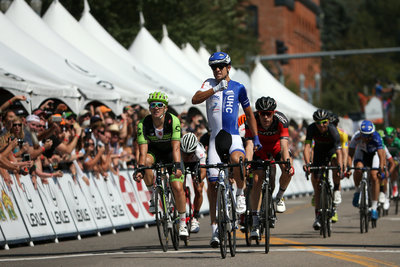
Race Radio: Reijnen's Favorite Ride, Dangerous Descending, Life in the Gruppetto
Kiel Reijnen loves training in Southern Colorado. Descending Independence Pass is a lesson in bravery. Riders in the gruppetto band together to get to the finish line.
 Kiel Reijnen’s Stage 3 win into Aspen proved once again that he is perhaps the most versatile rider in the USA.
Kiel Reijnen’s Stage 3 win into Aspen proved once again that he is perhaps the most versatile rider in the USA.
Reijnen is primarily a sprinter, and his thick legs can churn out a powerful burst of speed in the final meters of any race. Traditionally, however, sprinters like Reijnen struggle on the long climbs like Independence Pass. Compared to the ultra-skinny climbers, the muscular sprinters are the heavyweights of cycling. And on long climbs, that extra weight slows them down.
That’s where Reijnen is truly unique. Not only can he sprint, but he can also climb with the best in the bunch. In fact, it was Reijnen’s climbing skills on Independence Pass that kept him in contention for the win.
Reijnen has plenty of time to practice his climbing. He lives in Boulder, Colorado with his wife, and regularly trains on the long climbs there. And every summer, Reijnen also travels to his family’s cabin, which is located in the secluded town of Westcliffe, Colorado. Reijnen spends several months climbing into the Sangre de Cristo and Wet Mountain ranges from his secluded spot.
“There are a couple of serious dirt climbs out of Colorado City that go on forever,” Reijnen said. “It’s probably the most beautiful part of the state.”
Reijnen hails from Bainbridge Island, Washington, and picked up cycling in high school. He moved to Boulder in 2007 to attend the University of Colorado, and quickly became a star on the school’s cycling team. In 2009 he turned professional.
Reijnen refers to himself as an "adopted Coloradan." He said his favorite Front Range ride is to climb Squaw Pass out of Golden, descend into Idaho Springs, and then climb Oh My God road into Central City.
“I’ve been in Colorado 10 years now — I grew up here,” Reijnen said. “Winning here means a lot to me.”
Daredevils Down Independence We all know that pro cyclists climb mountains with remarkable speed. It’s the pace at which they descend those mountains, however, that is truly otherworldly. During Stage 3, the riders reached 60 miles per hour on the descent from Independence Pass.
We all know that pro cyclists climb mountains with remarkable speed. It’s the pace at which they descend those mountains, however, that is truly otherworldly. During Stage 3, the riders reached 60 miles per hour on the descent from Independence Pass.
An errant flick of the wrist or an untimely flat tire could have sent the group tumbling to the pavement, with little more than helmets and Lycra for protection. But nobody crashed, and the whole group arrived safely.
Jack Bobridge of the Budget Forklifts team said that the key to descending in a group is to watch the riders in front, as well as the pace motorcycle.
“If the motorbike is braking into a turn, then you should probably brake too,” Bobridge said. “You always look forward to see what is coming up.”
Gavin Mannion of the Jelly Belly team was also in the group. He said he experienced two “close calls” on the drop. Like Bobridge, Mannion said the key to descending dangerous roads is to be alert and anticipate corners.
Mannion said some riders may be less willing to take risks on the descents after a scary crash at the Tour of Utah involving MTN-Qhubeka rider Matt Brammeier. The descents, Mannion said, are part of the job.
“You see a lot of crashes in bike racing,” Mannion said. “The next day, you’re back on your bike, doing the same thing again.”
Life In the Gruppetto
Many pro cyclists struggle on the long climbs. Sprinters, domstiques and time trial specialists often find themselves dropped as soon as the road goes uphill. In longer stage races, such as the USA Pro Cycling Challenge, these riders band together in a group.
They then pace each other to the finish line, even though they race on different teams. That’s because all riders must finish within the time cutoff, or risk being disqualified.
This group is sometimes called “gruppetto,” “the laughing group” or “the autobus.”
Eric Young, the sprinter on the Optum P/B Kelly Benefit Strategies, said he enjoys the camaraderie in the grupetto. The riders all have the same objective, Young said, so riders are cordial. He said the attitude of riders in the grupetto often depends on how quickly they are dropped.
“When you get dropped closer to the finish line, the mood is always higher,” Young said. “The race is over for us and we’re just trying to survive.”












